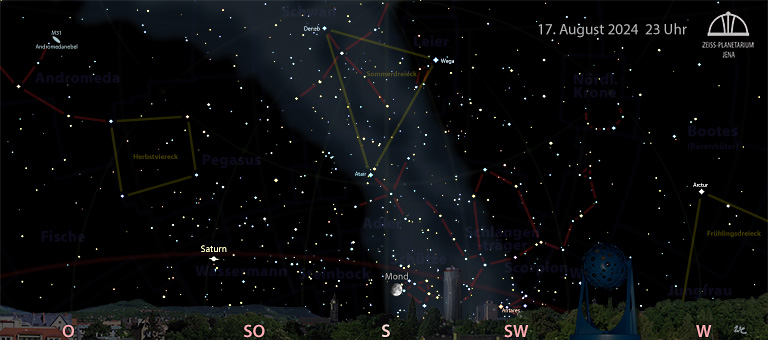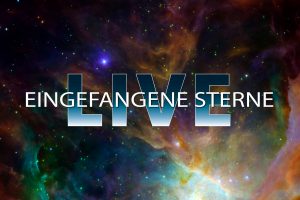3 Planeten und Sternschnuppen
In diesem Monat nimmt die Länge des hellen Tages bereits wieder um eine Stunde ab. Die Sonne verlässt am 10. das Tierkreissternbild Krebs und zieht vor den Löwen.
Vollmond ist am 19. August, Neumond am 4.
Die Hochsommernächte werden vom Sommerdreieck beherrscht. Hoch im Süden funkeln mit Deneb im Schwan und Wega in der Leier zwei der hellsten Sterne am irdischen Himmel. Unter ihnen vollendet der Atair im Adler das prachtvolle Dreieck. Das Sternbild Schwan ist auch als Kreuz des Nordens gut zu finden. In einer ganz klaren Nacht kann man sich gut vorstellen, wie beide Vögel mit ausgebreiteten Schwingen über das matt schimmernde Band der Milchstraße zu gleiten scheinen. Aber dafür sind schon sehr gute Sichtbedingungen erforderlich. Vier nicht sehr lichtstarke Sternchen, die ein kleines Parallelogramm bilden, formen zusammen mit der Wega das Sternbild Leier. Flach über dem Südhorizont sind die sommerlichen Tierkreissternbilder Waage, Skorpion, Schlangenträger, Schütze und Steinbock zu finden. Der rötlich funkelnde Stern Antares des Skorpions ist recht gut auszumachen.
Im Südosten erscheint der Ringplanet Saturn vor dem Tierkreissternbild Wassermann. Er bewegt sich ab 30. Juni rückläufig vor den Fixsternen, also von Ost nach West. Am 8. September ist seine Oppositionsstellung zur Sonne.
Der rote Nachbarplanet Mars ist im Nordosten vor dem Tierkreissternbild Stier und wird zum Planeten der zweiten Nachthälfte. Vor dem Stier ist auch der sehr helle Riesenplanet Jupiter zu sehen. Am 15.8. hat Mars den Jupiter überholt.
Am östlichen Himmel strahlen die Sterne des Herbstvierecks aus Pegasus und Andromeda.
Scheinbar aus dem Sternbild Perseus im Osten kommend, kann man die Sternschnuppen des Perseiden-Stroms erwarten, deren Maximum am Abend des 12. August liegt.
W. Don Eck
Zeiss-Planetarium Jena
The starry sky in August 2024
3 planets and shooting stars
This month, the length of the bright day decreases by another hour. The sun leaves the zodiacal constellation of Cancer on the 10th and moves in front of Leo. The full moon is on 19 August, the new moon on the 4th.
Midsummer nights are dominated by the summer triangle. High in the south, Deneb in the Swan and Vega in the Lyre are two of the brightest stars in the earthly sky. Below them, Atair in the Eagle completes the magnificent triangle. The constellation of the Swan is also easy to find as the Northern Cross. On a very clear night, it is easy to imagine how both birds appear to glide with outstretched wings over the matt, shimmering band of the Milky Way. But this requires very good viewing conditions. Four not very bright stars, which form a small parallelogram, form the constellation Lyra together with Vega. Just above the southern horizon are the summer zodiac constellations of Libra, Scorpio, the Serpent Bearer, Sagittarius and Capricorn. The reddish twinkling star Antares of Scorpio is quite easy to make out.
In the south-east, the ringed planet Saturn appears in front of the zodiacal constellation Aquarius. From 30 June, it moves retrograde in front of the fixed stars, i.e. from east to west. Its opposition to the Sun is on 8 September and its red neighbour Mars is in the north-east in front of the zodiacal constellation Taurus and becomes the planet of the second half of the night.
The very bright giant planet Jupiter can also be seen in front of Taurus.
Mars overtakes Jupiter on 15.8.
In the eastern sky, the stars of the autumn quadrilateral of Pegasus and Andromeda shine.
Apparently coming from the constellation Perseus in the east, you can expect the shooting stars of the Perseids stream, whose maximum is on the evening of 12 August.



